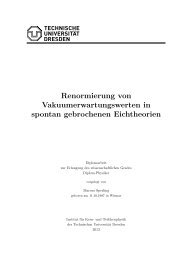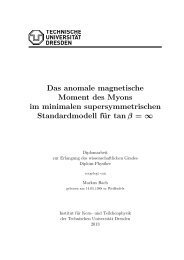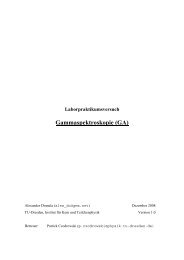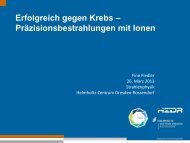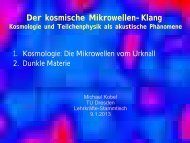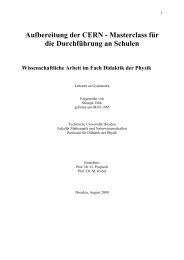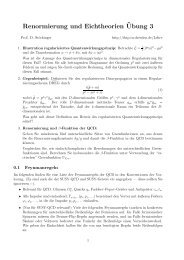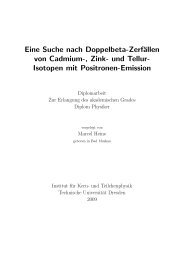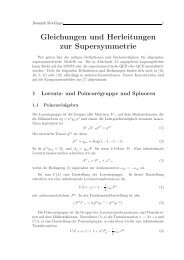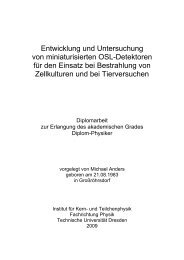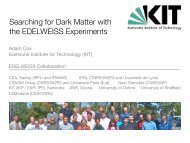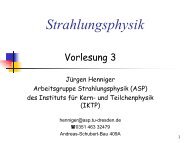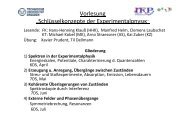a design study for a cobra upgrade to - Institut für Kern- und ...
a design study for a cobra upgrade to - Institut für Kern- und ...
a design study for a cobra upgrade to - Institut für Kern- und ...
Create successful ePaper yourself
Turn your PDF publications into a flip-book with our unique Google optimized e-Paper software.
5.1 Monte Carlo studies <strong>for</strong> the <strong>upgrade</strong> <strong>design</strong> 53<br />
cost and the amount of needed shielding material, smaller scintilla<strong>to</strong>rs<br />
would be preferable. Whereas, a good detection efficiency <strong>for</strong> gamma<br />
rays requires bigger scintilla<strong>to</strong>rs. For finding an optimal size of NaI:Tl,<br />
CsI:Tl, BGO and CWO crystals, the absorption efficiency of different<br />
scintilla<strong>to</strong>r crystals <strong>for</strong> gamma rays was determined with the simulation<br />
”ScintBlock”.<br />
GEANT4 APPLICATIONS ”SCINTBLOCK”<br />
The setup of this simulation consists of a volume of 2.5×2.5×5 m 3 filled<br />
with air. Within this, a cage of 2×2×4 m 3 containing nitrogen gas and,<br />
as default, a 1×1×1 m 3 CsI scintilla<strong>to</strong>r block is positioned. The user can<br />
change the size and the material of the target interactively via the commands<br />
/SB/det/setScintLength and /SB/det/setScintMat.<br />
The kind of the simulated particles and the physic processes are set<br />
in the PhysicsList class. All electromagnetic processes are defined <strong>for</strong><br />
pho<strong>to</strong>ns, charged lep<strong>to</strong>ns and charged hadrons. The primary kinematic<br />
consists of a single particle which hits the target perpendicular <strong>to</strong> the<br />
input face. The type of the particle and its energy are set in the PrimaryGenera<strong>to</strong>rAction<br />
class, and can be changed via the G4 build-in<br />
commands /gun/particle and /gun/energy of the ParticleGun<br />
class. As default a single 511 keV pho<strong>to</strong>n is initialised.<br />
SIMULATION AND DATA ANALYSIS<br />
Initially, a record of the number of the event (event ID), the number<br />
of the particle in the respective event (track ID), the kind of the particle<br />
(particle), the initial energy (Ei), the place of the interaction (x,y,z),<br />
the energy deposited in the scintilla<strong>to</strong>r (Edep), the kind of the interaction<br />
(process) and the amount of recorded steps (step) was printed <strong>for</strong><br />
every step with an interaction in the scintilla<strong>to</strong>r volume. In order <strong>to</strong><br />
<strong>und</strong>erstand the tracking of a particle, this detailed output was used <strong>to</strong><br />
reconstruct samples of simulated events.<br />
An event of the simulation of a 500 keV gamma ray in NaI is shown<br />
in table 5.1. The initial pho<strong>to</strong>n is back-scattered and produces three<br />
Comp<strong>to</strong>n electrons (track ID 4, 3 and 2) be<strong>for</strong>e leaving the scintilla<strong>to</strong>r.<br />
This is recorded as transportation process (trans). The Comp<strong>to</strong>n electrons<br />
number 4 and 3 loose their energy by ionization processes (eIoni)<br />
and the electron number 2 emits Bremsstrahlung (eBrems) be<strong>for</strong>e being<br />
absorbed. The Bremsstrahlungs pho<strong>to</strong>n is absorbed by the pho<strong>to</strong> effect<br />
(phot) and the produced pho<strong>to</strong> electron (track ID 6) is s<strong>to</strong>pped nearby.<br />
In <strong>to</strong>tal 840 simulations with different macros were started, changing<br />
the pho<strong>to</strong>n energy, the crystal material and the crystal size. For each<br />
simulation, the impact of 50000 monoenergetic pho<strong>to</strong>ns (one after the



